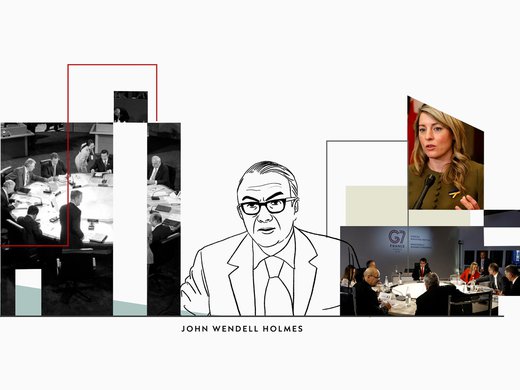This week, CIGI’s International Law Research Program (ILRP) is hosting a series of events exploring pressing issues in international environmental law. To kick off a week of sessions on translating climate change obligations from theory to practice, Professor of Law at Florida A&M College of Law and CIGI guest speaker Randall Abate delivered a timely talk on the role of the judicial system in limiting the effects of climate change.
CIGI Senior Fellow David Estrin’s recent paper on the emerging trend of citizen suits and domestic courts in tackling climate change assessed recent examples of judicial systems around the world holding governments accountable to their climate targets. To give us a U.S. perspective on the topic, we caught up with Abate to ask him a few questions about climate litigation and the evolution of environmental justice.
CIGI: In explaining the history and context of climate justice in the U.S., you mentioned the term “environmental racism”. Explain the history behind this term.
Randall Abate: The environmental racism movement came about in the mid to late 1980’s in the U.S. and it was primarily due to the fact that federal environmental laws were doing a very effective job of protecting resources – cleaning up the air, the water, and the land from pollution. But the missing piece to that scenario was protecting humans and how the effect of these environmental regulations were having a disproportionate, negative impact on communities of colour and low-income communities who were shouldering more of these environmental burdens than the rest of society.
For instance, in siting hazardous waste facilities or landfills, the vast majority of these environmentally undesirable land uses were located in these communities of colour primarily and that was largely due to these communities’ lack of economic resources and political influence to fight back from having those facilities in their communities so ultimately environmental racism grew out of this reality that this was something that the law should address and protect against proactively. That it shouldn’t be this unjust burden on these communities to have to bear these costs and health concerns that are connected to these facilities.
So that kind of human rights focus to environmental issues was what provided the foundation for climate justice, which is a much narrower kind of burdening of these communities. Many of these environmental justice communities are also climate justice communities because they are also economically unprepared to adapt to climate change impacts. Also included in this group are indigenous peoples who are very closely tied to the land and don’t have the ability to adapt to impacts such as sea level rise and other aspects of climate change affecting their livelihood and cultures.
CIGI: Could you give an example of a marginalized community dealing with the effects of climate change in recent history?
Abate: The biggest example in U.S. jurisprudence is the Kivalina case, which is an indigenous community of native Alaskans on the north slope of Alaska. There are only 400 people in this community. They are facing inundation from sea level rise. They live on a narrow strip of land that’s got water on both sides and sea level rise is causing their land to progressively go under water. The projection is that they may have 10 to 15 more years to live there before their land is completely submerged. They’ve become the iconic community for what climate justice means in the U.S. in the sense that they are an indigenous community; they lack the resources to protect themselves; and they need federal or state assistance, or the right outcomes inthe courts to secure a remedy so they can foot the bill of US$400 million to relocate their community of 400 just 10 miles inland to get out of harm’s way. So that was a prominent U.S. example.
Throughout the South Pacific, there are low-lying island nations looking to international law to try to find a way to compel the developed world to have some kind of mechanism in place to fund their relocation and also to have international law protections that will enable them to retain their nation status even when they have to flee their homeland.
CIGI: The use of the Ninth Amendment throughout history has provided some unique rulings. You have noted that this amendment provides a foothold for creative lawyers to make climate justice arguments. What do you mean by this?
Abate: Atmospheric trust litigation (ATL) is the latest version of creative litigation for climate justice purposes. The ATL movement is spearheaded by this organization called Our Children’s Trust, based in Oregon. They are involved in 50 cases being filed in the U.S. seeking to compel state governments to regulate climate change on behalf of these current and future generations of youth so they can have a planet to call home as we did.
The theory of the litigation by these plaintiffs is against the federal government and against state governments. So it was the suit against the federal government that involved drawing on U.S. constitutional provisions: the Due Process Clause, the Equal Protection Clause and the Ninth Amendment. The idea is that those three constitutional protections taken together are being used to try to fashion a right to a clean environment for future generations.
The Due Process Clause involves a reference to right to life. The Equal Protection Clause argument is the notion that these future generations are being treated differently and unfairly as compared to current generations and they ought to have some way of current generations advocating on their behalf – it’s unfair that they inherit an earth that is doomed. The Ninth Amendment provides that just because something is not expressly enumerated in the U.S. Constitution doesn’t necessarily mean that people don’t have that right. The U.S. Constitution doesn’t have a right to a healthy environment language in it, but our societal values and the jurisprudence in our courts may evolve in a way that courts will be able to recognize that our constitution embraces that idea, even though it doesn’t say it expressly.
The right to contraception and a woman’s right to choose evolved in a similar way, drawing on the Ninth Amendment. Those references weren’t in our constitution, but the courts were able to recognize it as a constitutionally protected privacy right.
CIGI: There is some debate around whether or not the political climate is ripe for these cases to succeed. Do you have a sense of the potential for success in the U.S.?
Abate: What we have in the U.S. is a bifurcated reality where the governmental entities are not embracing climate change regulation. Congress is not acting. The Executive Branch efforts under the Bush and Obama administrations were not enough. Even though we made some foreign policy progress under Obama in terms of being more involved in climate change regulation at an international level, the U.S. is still not doing enough to address its responsibility to regulate climate change.
The contrast to that is a real divide among the American people, where the issue has become very politicized and essentially many Republicans do not believe climate change needs to be regulated, whereas many Democrats believe it needs to be regulated. And so those that are in favour of regulating climate change are the people bringing cases into the courts. The judicial system has been far more receptive to the need to regulate climate change than Congress and the Executive Branch have.
So that’s where the U.S. is right now. They’re achieving valuable strides forward through the court system in these creative cases, and yet they’re doing so against the backdrop of governmental actors in the other two branches that are not where they need to be on the importance of regulating climate change.
CIGI: What is important to keep in mind as the environmental justice movement moves forward?
Abate: With climate change regulation in general, it’s a challenge on so many levels because you’re faced with managing the science. Even though there is significant consensus on the realities of human-induced climate change and its impacts from leading scientists throughout the world, questions remain regarding how aggressively to regulate and how soon. That is balanced against the reality that it is expensive to regulate climate change. As much as any of us wants to be in favour of protecting the planet for future generations, there are harsh economic realities that we can’t overlook regarding the cost of regulating climate change. This is why it’s so important to get information to the public on these issues, and move away from it being a knee-jerk political issue. We need to understand what we are facing instead of seeing it as a hoax or a doomsday scenario – the reality is somewhere in between those two extremes.
Whether it’s the U.S. or the international community, dialogue about these issues is the only way to move forward and separate the myths from the truths. We need a strategy to regulate these issues in the courts, but the courts aren’t supposed to legislate from the bench. The courts can, however, provide a valuable impetus for the legislative bodies and international treaty negotiations to address climate harm.


